Notes
Your Turn: More Strut, Less Tut
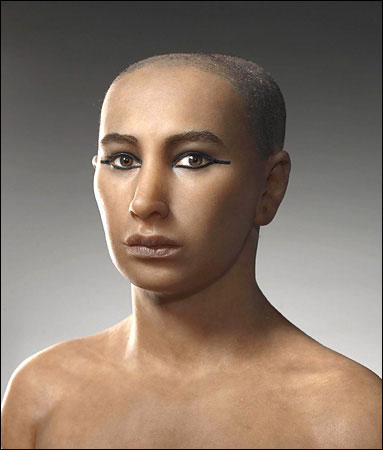
Are looks worth more than gold? Is a weak chin a fatal flaw? From the BAG’s standpoint, it’s hard to tell what or where the story is here.
Is it the unveiling of a realistic image of King Tut based on the analysis of over 1,700 three-dimensional CT scans interpreted by teams of artists and scientists from three different nations?
Is it the rendering of that image, and what the representation has to say about cultural stereotypes and the obsession with appearance and beauty?
Or, is it the way the NYTimes interpreted the image in its on-line headline (Tut Was Not Such a Handsome Golden Youth, After All) and its caption (Not the Golden Boy, After All) concentrating on color and looks, and the conclusion that the figure is unattractive?
If you’re not familiar with the story, King Tut died around 1325 B.C. at the approximate age of 19. Discovered in 1922, the mummy was X-rayed about thirty years ago. With the advent of advanced medical scanning technology, the antiquities council in Egypt commissioned three international teams to create a likeness from a set of scans. The teams worked independently. The teams from France and Egypt knew the body was that of Tut. The U.S. team did not. The Americans and French did their interpretation using a plastic skull, while the Egyptians directly analyzed the CT scans. The Americans produced a plaster model, the French a silicone one.
In terms of results, all three groups basically agreed on the skull proportions, the basic facial shape and eye size and settings. However, because of the diminished condition of the original mummy, the teams came up with different shapes for the ears and nose. However, the biggest difference was in the chin. Apparently, the American and French produced a weak chin, while the Egyptians created a stronger one.
The image above was created by the French. It’s the version that has splashed through the media over the past 12 hours (including the original NYTimes on-line version). A decided less sexy version — created by the Egyptians — is shown here.
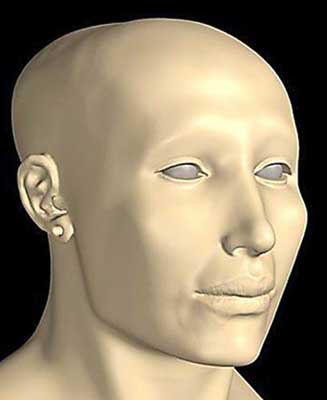
Here is the American Tut.
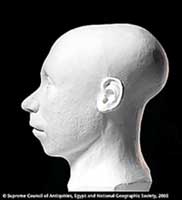
(And, for the sake of comparison, here is an image misidentified by the Washington Post as one of the CT-based reconstructed images. According to readers of this site, it is a sculpture that was found in the real tomb.)
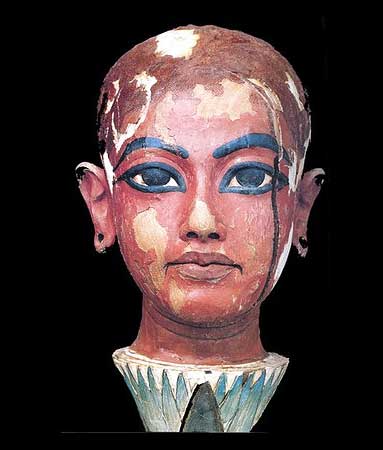
So, here are a few questions you might want to take a shot at:
Contrary to a headline writer at the NYTimes, who is to say the figure (on top) isn’t attractive?
Does the Times subtlety inject race into the story? In stressing that Tut is no longer “golden,” aren’t they unwittingly calling attention to the fact Tut is actually brown (and somehow lesser for it)?
Is the Time’s headline simply cheap confirmation that the West’s more affluent cultures have become hopelessly obsessed with image, surface and physicality?
Considering the background; lighting; bare shoulders and chest; and the sensuous painting of the eyes and eyebrows, how much is the French version “hijacked” by its composition? (In other words, how much are we looking at a rigorous reconstruction of Tut, as opposed to a modeling agency version of the King’s head shots?)
Does it seem like the French make-over has a “queer eye” aspect to it?
Does the French image “take history for a ride” in the same way Hollywood will dumb it down or glamorize it, Disney will appropriate it, and the Discovery Channel will make a soap opera out of it?
How do you account for the different chins? Short on data, were the Egyptians going with what looks good at home?
Why did the Americans go with a profile? (Or, why is the media using the profile to represent the American version?) Does the U.S. always have to go its own way?
What does this say about the French?
Where am I off? What else am I missing?
(WAPO story here. NYT story here.)
(revised: 3/11/05. 9:14am PST)
(image 1: Egyptian Supreme Council of Antiquities/National Geographic Society May 10, 2005 in nytimes.com. Image 2: AP/Egyptian Supreme Council of Antiquities. May 10, 2005 in The seattletimes.nwsource.com. Image 3: AP/Egyptian Supreme Council of Antiquities/ HO. May 10, 2005 in The washingtonpost.com.)
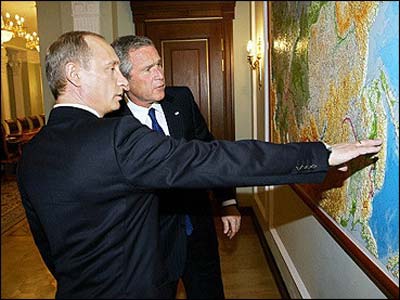

Reactions
Comments Powered by Disqus